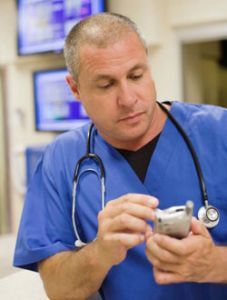Article
Concern Grows Over Digital Distraction in Medical Settings
Author(s):
As the number of digital devices in the hospital setting multiplies, we may be entering a "digital nightmare" in which health care providers are so preoccupied with gadgets that patient care suffers significantly.

As the number of digital devices in the hospital setting multiplies, we may be entering a “digital nightmare” in which health care providers are so preoccupied with gadgets—sometimes put to medical use, but frequently not—that patient care suffers significantly. So argues Peter J. Papadakos, MD, a professor of anesthesiology, surgery, and neurosurgery at the University of Rochester, in an article in the November edition of Anesthesiology News.
Whereas in his formative years in the late 1970s and 1980s, Papadakos notes that there were strict prohibitions on engaging in distracting behavior in the hospital, today a great deal of computer interface is required to access electronic health records and patient care data, which puts a barrier between providers and patients even when the former are not engaged in personal electronic behavior. Add in ubiquitous smartphones that allow for calls, texts, games, and Internet access, and the stage is set for widespread distraction.
Data on rates of such digital distraction and its impact are scarce, though Papadakos reports that a study presented at the 2011 annual meeting of the American Society of Anesthesiologists found that nurse anesthetists and residents were distracted by matters other than patient care (including the Internet) 54% of the time, even when they knew they were being watched. Another study, which appeared in the September 2011 edition of the journal Perfusion, found that digital distractions were extremely common among perfusionists during cardiopulmonary bypass (CPB)—as was concern over the hazards posed by such distraction.
In the study, 439 participants (30.5% chief perfusionists, 62% staff perfusionists, 7.5% other) responded to an online survey. Use of a cell phone during CPB was reported by 55.6% of perfusionists, and text messaging during CPB was reported by 49.2%. Other activities reported by perfusionists during CPB included checking e-mail (21%), surfing the Internet (15.1%), and accessing social networking sites (3.1%). Despite their widespread use of devices, 78.3% of respondents said that cell phones can introduce a potentially significant risk to patients, with 42.3% saying that speaking on a cell phone during CPB was “always an unsafe practice” and 51.7% saying the same about text messaging during CPB. Finally, 7.3% said they had been distracted by cell phone use in a manner that negatively affected their performance, and 51.7% said they had witnessed another perfusionist negatively affected in this manner.
An article on "distracted doctoring" in yesterday’s New York Times that referenced both the Anesthesiology News article and the Perfusion study reported that hospitals are limiting use of devices in critical settings and medical schools are emphasizing the importance of focusing on patients rather than gadgets. The article included several disturbing examples of such behavior by health care professionals: A malpractice lawyer describes a case in which a patient was partially paralyzed as the result of surgery during which the neurosurgeon made at least 10 personal cell phone calls using a wireless headset; a doctor at Yale-New Haven Hospital reports that the browser trail on computers in the intensive care unit offers evidence of an array of non-medical activities: Amazon, Gmail, eBay, etc.; and an administrative director at Oregon Health and Sciences University hospitals describes having to lecture a nurse for checking airfares in the operating room during an operation.





